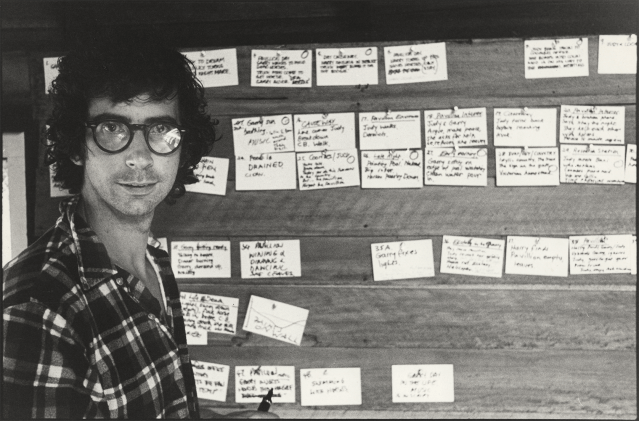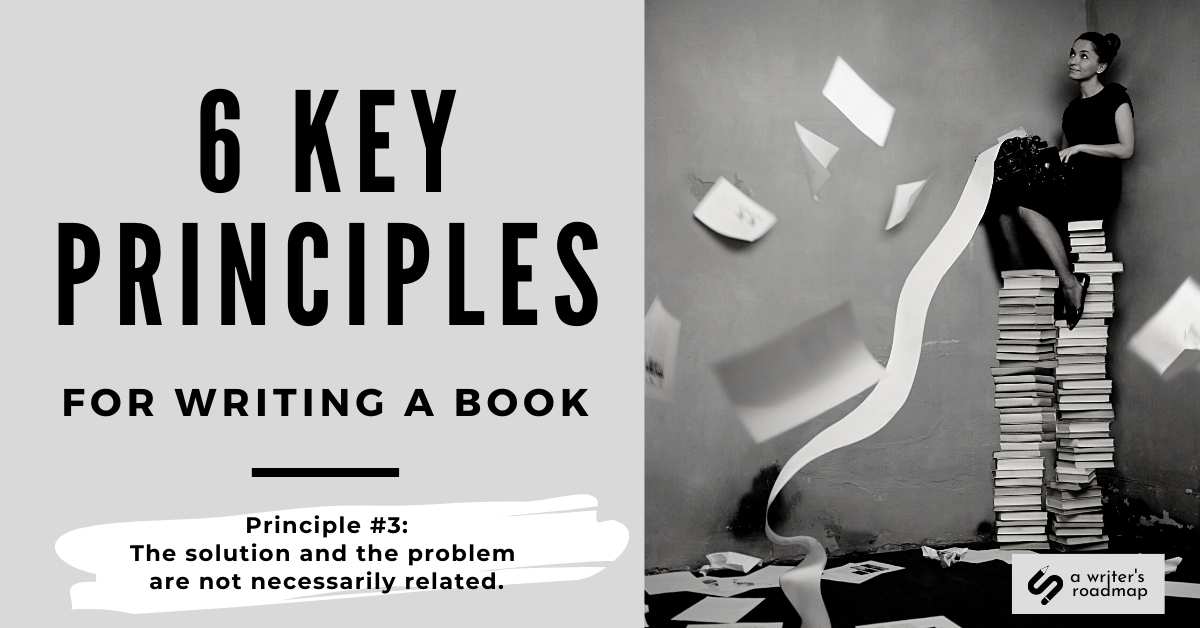- No single approach works for everyone
- The simplest and least invasive approach is frequently the best
- The solution and the problem are not necessarily related
- Change is happening all the time
- Focus on strengths and resources rather than weaknesses and deficits
- Focus on the present, rather than the past or future.
“We cannot solve our problems with the same thinking we used when we created them.”
Albert Einstein
Principle #3: The Solution and the Problem Are Not Necessarily Related
This principle suggests that no solution can be ruled out for any writing problem until the problem can be identified.
Let’s say the problem is that you have nowhere to write.
You might consider solving the problem directly by moving, or going to the library, or borrowing a friend’s apartment, or writing in your car.
First, what’s the real problem?
Is the problem really nowhere to write?
Or is it a lack of privacy?
Is it about needing room to spread out your stuff?
Or is it fear of disappointing yourself with a badly written book?
Is the problem that writing is hard?
I’ve been writing for a long time and I’m still not sure if it’s hard.
Writing this sentence is easy. Five little words. Pfft!
Writing a book…that’s something else.
Is it hard because books are complicated?
Or because they can take a while?
Here’s a crazy idea. I think the problem is one of size and organization. Books are long and they don’t really exist until they’re published. Just finding a way to work with something as ephemeral as black marks on a page can be tricky. All those ideas and words and scenes and chapters!
I’ve worked with more than one writer who’s written the same section of a book multiple times–not to improve the draft, but because they couldn’t find the original snippet.
Some writers save individual chapters, some use Scrivener or other software to keep it organized, some print pages out and store them in binders.
I’ve been writing longhand as an experiment, and I have to write on what’s handy. At this point, 3 separate notebooks are in use. They’re all around somewhere. Half of the time when I think about the book, I’m literally thinking about where the hell it is and how disoriented I feel.
Thinking of Nabokov
So let’s say that the problem is not nowhere to work, but nowhere for the book to exist while you write it.
Annie Dillard (Pulitzer Prize winner) writes:
“How fondly I recall thinking, in the old days, that to write you needed paper, pen, and a lap. How appalled I was to discover that, in order to write so much as a sonnet, you need a warehouse. You can easily get so confused writing a thirty-page chapter that in order to make an outline for the second draft, you have to rent a hall. I have often “written” with the mechanical aid of a twenty-foot conference table. You lay your pages along the table’s edge and pace out the work. You walk along the rows; you weed bits, move bits, and dig out bits, bent over the rows with full hands like a gardener. After a couple of hours, you have taken an exceedingly dull nine-mile hike.”
Annie Dillard, The Writing Life
Here’s Peter Carey (two-time Booker prize winning novelist)’s in the 1970s with what looks very much like a Scrivener screen come to life:

And here’s Carey’s evolving solution to corralling his books as reported in The Paris Review in 2006:
For his last few novels, he has had drafts bound into what he calls “working notebooks.” The first one, made for The Kelly Gang, was “huge, heavy, and annoying to carry through the bush”; the more recent ones use lighter paper with wide margins for notes. The pages are rough (“I type so badly, it’s appalling,” he said), with passages highlighted to indicate where further research is necessary; the margins hold chapter plans and plot points, calendars and timelines, and occasionally pasted-in postcards—anything relevant to the story in progress. Though the notebooks speak to Carey’s talent for weaving history and legend into his own richly invented worlds, they also illustrate his editorial rigor. “For a writer,” he says, “the greatest thing is to be able to pare away.”
The Paris Review – Peter Carey, The Art of Fiction No. 188
Here’s novelist Vladimir Nabokov (7-time finalist for the National Book Award)’s solution: Index cards. Yes, he wrote novels on index cards! Then his wife typed them up.
Could you write an entire novel on index cards? I don’t know if I could….but it worked for him.

Once you know the problem…you can really get the solution
Here’s where Principle #3 really shines.
Our original problem was about having nowhere to write.
First, if you’re sure that is the problem, accept your certainty. Your experience is always valid.
Then think about how a place to write can materialize.
The solution might be using a place you already have access to but in a particular time frame, with specific visual cues (a folding screen, a warning sign) that tell you and anyone else around that this is now your place to write.
A problem of place takes the solution of time and visual cues.
On the surface, my own problem was about the difficulty of working with a book-in-progress due to its sheer volume. I’m 3 notebooks in on the first 25% of the book, and it’s not written in order. I feel disoriented and disorganized every time I thinking about writing more.
But the solution is not actually related to organizing the material or indexing the notebooks.
The solution is to not give a fuck about what I already wrote.
I won’t throw the notebooks out, of course!
But my task is clear. The task is to finish the draft.
The solution is to fill up the 3rd notebook, and one after that, and one after that.
When it’s all done, I’ll have the easiest task in the world: typing it up. Just like Nabokov’s wife.
A problem of disorganized material takes the solution of producing more material. It means saving the organization of it until after the most important task is done.
Next up: Principle #4
Change is happening all the time.
If you don’t want to miss this KEY PRINCIPLE, I hope you’ll sign up for the Thursday Postcard!

